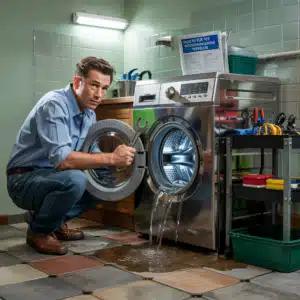How to Fix a Washing Machine That Overflows – Step-by-Step Guide
Introduction: Why Is My Washing Machine Overflowing?
A washing machine that overflows can turn laundry day into a messy nightmare. Whether you’re dealing with a top-load washer flooding the floor or a front-load model leaking suds, the problem usually stems from a few common issues.
In this guide, you’ll learn exactly how to fix a washing machine that overflows, including:
✔ Clogged drain solutions
✔ Sensor and valve repairs
✔ Overloading and detergent fixes
✔ Standpipe and plumbing adjustments
We’ll cover Samsung, LG, Whirlpool, and other major brands, with tips to prevent future overflows. Let’s dive in!

Why Do Washing Machines Overflow?
Understanding why your washing machine overflows is the first step in learning how to fix a washing machine that overflows. Here’s a comprehensive breakdown of the 7 most common reasons:
1. Clogged Drain Hose or Filter
When learning how to fix a washing machine that overflows, start by checking the drain system. Lint, debris or small objects block water flow, causing backups. Front-load models with filters are especially prone. Regular cleaning prevents this issue – a key tip when discovering how to fix a washing machine that overflows due to drainage problems.
2. Faulty Water Level Sensor
A malfunctioning sensor won’t stop filling, leading to overflows. Samsung and LG washers commonly experience this. Part of knowing how to fix a washing machine that overflows involves testing the pressure switch with a multimeter or replacing it if defective.
3. Overloading the Machine
Understanding how to fix a washing machine that overflows includes proper loading. Too many clothes trap water, especially in top-load agitator models. Leave space between clothes and tub rim – this simple step often solves overflow issues without repairs.
4. Excessive Detergent
When exploring how to fix a washing machine that overflows, detergent amount matters. Too much creates foam that triggers sensors. Use just 1-2 tablespoons of HE detergent – a crucial detail in preventing suds-related overflows in front-load units.
5. Standpipe Problems
Proper installation is vital when learning how to fix a washing machine that overflows. A standpipe under 30″ tall or narrower than 2″ causes drainage backups. Ensuring correct plumbing specs prevents many overflow situations before they occur.
6. High Water Pressure
Part of knowing how to fix a washing machine that overflows involves checking water pressure. Above 80 PSI forces too much water in too fast. Installing a pressure regulator solves this systemic cause of overfilling.
7. Faulty Inlet Valve
The complete guide to how to fix a washing machine that overflows must address valve failures. Worn valves leak continuously, often requiring replacement. This repair typically needs professional assistance for proper diagnosis and installation.
If your washing machine is shaking violently during spin cycles, this could indicate an unbalanced load, worn shock absorbers, or improper leveling. While our guide on why your washing machine shakes violently explains how to troubleshoot these issues, persistent shaking may require professional repair—especially if you notice leaks accompanying the movement. For severe cases where vibrations lead to water overflow, our technicians can diagnose whether you’re dealing with a faulty suspension system, broken counterweights, or an unstable installation. Book a same-day service to prevent further damage to your machine or flooring.

How to Fix a Washing Machine that overflows
How to Fix a Washing Machine That Overflows
-
Unclog the drain hose – Check for lint/debris, use a plumber’s snake for deep clogs, and clean the filter monthly (front-load models).
-
Reset/replace water level sensor – Unplug for 5 minutes, test with multimeter (0-110 ohms), or replace if faulty (Samsung models often need recalibration).
-
Avoid overloading – Follow manufacturer’s load guidelines, leave 6″ space at the top, and wash bulky items separately.
-
Reduce detergent – Use max 2 tbsp HE detergent, run rinse cycles for excess suds, and halve detergent in hard water areas.
-
Adjust standpipe – Ensure 2″ diameter and 30-36″ height; never drain directly into sewer lines.
-
Check water pressure – Ideal is 40-80 psi; install a regulator if over 80 psi or partially close supply valves.
-
Replace inlet valve – Shut off water, disconnect hoses, and install new valve (20−60) if leaking or corroded (lifespan: 5-10 years).
If your washing machine continues to overflow despite troubleshooting, it might need professional attention. At Technical Sewa, we offer expert washing machine repair services to diagnose and fix issues like faulty sensors, drain pump failures, or electrical problems. Our certified technicians handle all major brands, including Samsung, LG, Whirlpool, and IFB, ensuring quick and reliable solutions. Whether it’s a clogged drain, persistent leaks, or error codes, schedule a service today for same-day repairs and hassle-free laundry days!
For persistent issues, consult a professional for electrical or major plumbing problems.
FAQ: How to Fix a Washing Machine That Overflows
1. Why Does My Washing Machine Keep Overflowing?
A washing machine overflows due to:
-
Clogged drain hose/filter (lint, debris, or small objects blocking water flow)
-
Faulty water level sensor (fails to detect when the tub is full)
-
Overloading (too many clothes trap water and prevent drainage)
-
Excessive detergent (creates foam that triggers overflow errors)
-
Standpipe issues (incorrect height/diameter causes backups)
-
High water pressure (forces too much water into the machine too quickly)
Quick Fix: Check the drain hose first—it’s the most common culprit.
2. How Do I Unclog a Washing Machine Drain Pipe?
Step-by-Step Solution:
-
Unplug the washer and pull it away from the wall.
-
Locate the drain hose (usually at the back).
-
Remove clogs by hand or use a plumber’s snake.
-
Flush with hot water & vinegar to dissolve residue.
-
Reattach the hose and run a test cycle.
Pro Tip: Clean the drain filter monthly (front-load models only).
3. Can Overloading Cause a Washer to Overflow?
Yes! Overloading:
-
Prevents proper water circulation
-
Traps water inside the drum
-
Forces excess water out through seals
Solution:
-
Follow the manufacturer’s load capacity (usually ¾ full for top-load, ½ full for front-load).
-
Leave 6 inches of space at the top of the drum.
4. Why Does My Washer Overflow with Foam?
Causes:
-
Too much detergent (especially non-HE detergent in front-loaders)
-
Hard water (requires less soap)
-
Fabric softener buildup (creates excess suds)
Fix:
-
Use 1-2 tbsp of HE detergent max.
-
Run an extra rinse cycle to clear suds.
-
Avoid fabric softener if foam persists.
5. How Do I Fix a Washer That Overflows on the Rinse Cycle?
This usually indicates a drainage issue:
-
Clogged drain hose (check for blockages)
-
Faulty drain pump (listen for humming—no sound means it’s broken)
-
Standpipe too short (must be 30-36 inches tall)
Solution:
-
Clear any clogs.
-
Test/replace the drain pump if needed.
-
Extend the standpipe if necessary.
6. Will a Washing Machine Work After Flooding?
Maybe, but proceed with caution:
-
Unplug immediately to avoid electrical damage.
-
Dry all components (motor, control board, sensors).
-
Check for error codes (e.g., “UE” for unbalanced load).
-
Test with a small load—if it still malfunctions, call a technician.
Warning: If floodwater was contaminated, replace internal parts to prevent mold.
7. Why Does My Standpipe Keep Overflowing?
Common Reasons:
-
Pipe is too narrow (needs 2-inch diameter).
-
Improper height (must extend 30-36 inches above the trap).
-
Clogged vent stack (causes slow drainage).
Solution:
-
Replace with a wider pipe if needed.
-
Ensure proper venting in your plumbing system.
8. How Do I Lower Water Pressure in My Washer?
If pressure exceeds 80 psi:
-
Install a pressure regulator (20−50 at hardware stores).
-
Partially close the supply valves behind the washer.
-
Test pressure with a gauge (ideal: 40-80 psi).
Note: High pressure is common in homes with well pumps.
9. Can Too Much Detergent Cause Leaks?
Yes! Excess detergent:
-
Creates foam that overwhelms the drain system.
-
Forces water out through door seals/venting.
-
Leaves residue that clogs pipes over time.
Fix:
-
Use HE detergent in front-loaders.
-
Measure detergent carefully—less is more!
10. What If My Washer Overflows with Sand?
Likely Causes:
-
Sandy clothes (beach trips, work gear).
-
Broken drum seal (allows sand into the drain).
Solution:
-
Clean the drain pump filter (sand collects here).
-
Run empty rinse cycles to flush out residue.
-
Inspect the drum seal for wear.
11. How Do I Clean the Overflow Pipe?
Steps:
-
Locate the pipe (usually behind the washer).
-
Soak in hot water + baking soda to dissolve buildup.
-
Use a bottle brush to scrub inside.
-
Rinse thoroughly before reattaching.
Frequency: Every 3-6 months if you have hard water.
12. When Should I Call a Repair Technician?
Call a pro for:
🔧 Electrical issues (burning smell, sparks).
🔧 Major leaks (water gushing out uncontrollably).
🔧 Persistent error codes after DIY fixes.
Prevent future overflows with SmartCare’s annual maintenance plans which include drain cleaning, sensor checks, and performance optimization.”